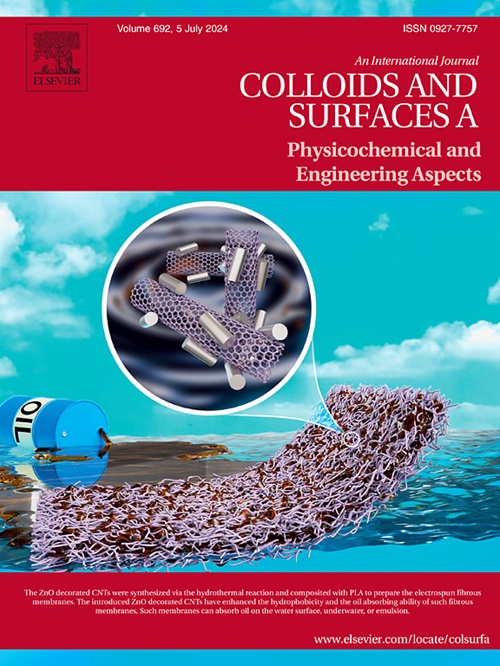Enhancing photocatalysis for organic pollutant degradation: A study on core-shell S-scheme C/Cu PDA/BiOBr heterojunctions nanoreactors
IF 4.9
2区 化学
Q2 CHEMISTRY, PHYSICAL
Colloids and Surfaces A: Physicochemical and Engineering Aspects
Pub Date : 2025-04-29
DOI:10.1016/j.colsurfa.2025.137070
引用次数: 0
Abstract
The formation of black nanoclusters by chelation between metal ions and dopamine is expected to be used for efficient utilization and conversion of solar energy. As a semiconductor material, BiOBr is widely used in the degradation of organic pollutants. However, its photocatalytic efficiency is limited by the wide band gap and the rapid recombination of photogenerated carriers. The construction of heterojunctions is considered to be an effective way to improve the photogenerated charge separation of BiOBr. However, the slow electron transfer is mostly due to poor interface contact and non-directional electron transfer inside the heterojunction. In this study, an S-scheme C/Cu PDA/BiOBr heterojunction photocatalyst was designed and constructed. It was used for the rapid photoreduction degradation of organic dye Congo red by in-situ chemical growth combined with freeze-drying two-step process. The optimal removal efficiency of Congo red by C/Cu PDA/BiOBr heterojunction can reach 100 %. The enhanced photocatalytic performance can be attributed to the following key factors: 1)The introduction of C/Cu PDA improves the conductivity of the material and the ability to respond to visible light, and increases the light absorption range. 2)High-quality heterogeneous interface reduces the rapid recombination of carriers. 3)The S-scheme heterojunction improves the spatial separation ability of photogenerated charges and retains the conduction band and valence band with strong redox properties. This study innovatively provides in-depth insights into the photoreduction of CR and demonstrates an environmentally friendly pollutant degradation method.
增强光催化降解有机污染物:s -壳型C/Cu PDA/BiOBr异质结纳米反应器的研究
金属离子与多巴胺螯合形成的黑色纳米团簇有望用于太阳能的高效利用和转化。BiOBr作为一种半导体材料,在有机污染物的降解中有着广泛的应用。然而,它的光催化效率受到宽带隙和光生载流子快速重组的限制。异质结的构建被认为是改善BiOBr光生电荷分离的有效途径。然而,电子转移缓慢主要是由于界面接触不良和异质结内部的非定向电子转移。本研究设计并构建了S-scheme C/Cu PDA/BiOBr异质结光催化剂。采用原位化学生长结合冷冻干燥两步法对有机染料刚果红进行了快速光还原降解。C/Cu PDA/BiOBr异质结对刚果红的最佳去除率可达100% %。光催化性能的增强可归因于以下关键因素:1)C/Cu PDA的引入提高了材料的电导率和对可见光的响应能力,增加了光吸收范围。2)高质量的异构接口减少了载体的快速重组。3) s型异质结提高了光生电荷的空间分离能力,保留了具有强氧化还原性质的导带和价带。本研究创新性地为CR的光还原提供了深入的见解,并展示了一种环境友好的污染物降解方法。
本文章由计算机程序翻译,如有差异,请以英文原文为准。
求助全文
约1分钟内获得全文
求助全文
来源期刊
CiteScore
8.70
自引率
9.60%
发文量
2421
审稿时长
56 days
期刊介绍:
Colloids and Surfaces A: Physicochemical and Engineering Aspects is an international journal devoted to the science underlying applications of colloids and interfacial phenomena.
The journal aims at publishing high quality research papers featuring new materials or new insights into the role of colloid and interface science in (for example) food, energy, minerals processing, pharmaceuticals or the environment.

 求助内容:
求助内容: 应助结果提醒方式:
应助结果提醒方式:


